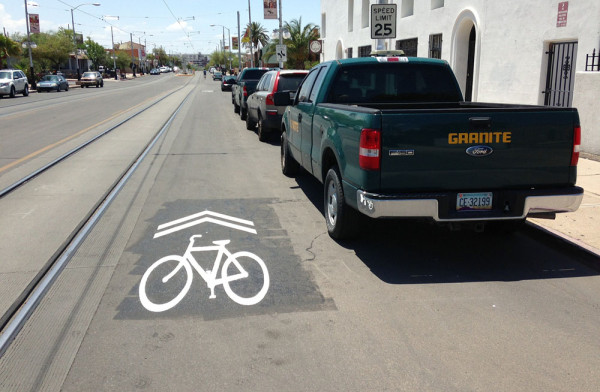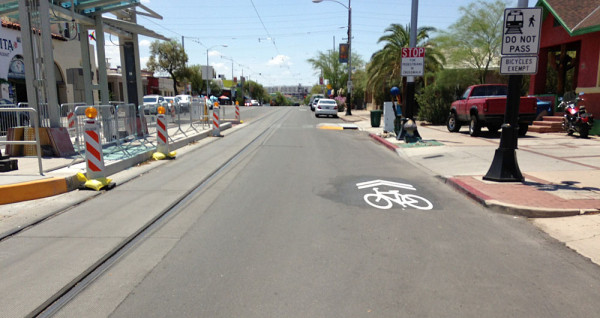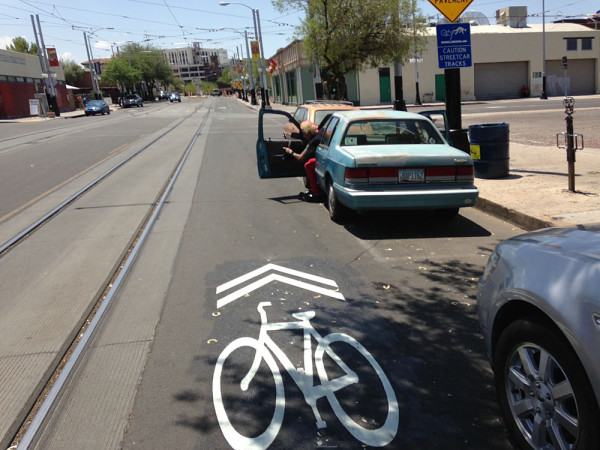
New sharrows along Fourth Avenue appear to place cyclists in or dangerously close to the door zone. (Check the video at the end of the post to find out what the door zone is.)
City crews Contractors placed the pavement markers heading south on Fourth Avenue between the streetcar tracks and the parked cars.
The sharrow above is the first sharrow cyclists encounter heading south on Fourth Avenue after passing University Boulevard. Assuming cyclist would ride directly down the center of the sharrow, a rider would hit a parked car.
It’s unclear if parking along that stretch will be eliminated and the Ann Chanecka, the city’s bicycle and pedestrian program manager could not be reached for clarification. Even if parking is removed at that location, riders will have to move away from the curb to avoid parked cars further down the road presenting challenges with merging into traffic.
The center of the next sharrow, which you see above, is 4.5 feet away from the edge of this track, which is parked very close to the curve. A cyclist riding down the center of the sharrow would likely crash into the door if it was opened.
When cyclists get to a streetcar stop, the sharrows move toward the curb. Again a cyclist will have to merge back into the travel lane. It is safer to remain near the tracks to prevent a car from trying to pass and avoiding a conflict when moving back into the lane to avoid parked cars.
As you can see from this image, riding down the center of the sharrow would likely result in a collision since on average, handlebars extend about nine inches on either side of the bike. This motorist is not within the white lines, but as we’ve seen, that is common practice on Fourth Avenue.
We will follow up with the city to see if any adjustments will be made.
Regardless of the new sharrows, I will continue riding a few inches to the right of where the concrete and asphalt meet. What about you?




Will the streetcar have handrails on the outside so we can grab onto it?
Mike, I am very appreciative for what you (and therefore, TucsonVelo) provide to the Tucson cycling community. But I think that this particular article may be a bit over-the-top in critiquing what the City is doing on 4th Avenue. I agree that the situation created by the design of the Modern Streetcar is not optimal for cycling safety, but I think there is a point where we as cyclist must take responsibility for our own safety.
It is my understanding that sharrows are used to show drivers that the road/lane is to be shared with cyclist … sharrows are not intended to show where a cyclist is to ride. If a cyclist is not aware enough to stay out of the “open door” zone, then they are the one creating the risk of hitting a suddenly opened door (and yes, the person opening the door is also responsible for not checking to see if there are bikes/cars approaching).
Would it be nice if the City provided we cyclist with buffered or separated bike paths/lanes throughout the City … most certainly, yes… but not realistic to expect. I think that what the City and County are doing for us is a great improvement over the past. Projects in the works will improve the cycling infrastructure … we should celebrate improvements, not offer “post-installation” critiques.
Keep up the good journalistic work, Mike … I for one appreciate your efforts.
@Randy Garmon
Cyclists control and judgement being just one of the variables that determine outcomes on public thoroughfares. Arguably a factor that plays a larger role in safety is roadway design. Lacking direct access to AASHTO sharrow placement guidelines I’m linking to a Caltrans document that discusses this topic and has a drawing at the end in which the AASHTO placement minimums are shown. This document is from 2011 and isn’t a complete reference but it does show some of the engineering thinking regarding sharrow placements in California in 2011. I’d be thrilled if someone was able to dig up a more current complete reference on the topic.
http://www.dot.ca.gov/hq/traffops/signtech/mutcdsupp/pdf/camutcd2011draftrev/100311RMarshall.pdf
@Randy Garmon I appreciate the feedback, Randy. I agree that most people who read this site will ride father to the left knowing they need to stay out of the door zone. Sharrows are used BOTH to illustrate to motorist that bikes will be in the road AND to illustrate where cyclists should ride (http://bikepedantic.files.wordpress.com/2012/08/sharrowsr5.pdf)
It’s the newer riders that the city wants to attract. 4th Avenue is exactly the destination a newer cyclist would want to ride to. They are also less likely to know about the door zone and the position of the sharrows, which to a new cyclist would appear to show them where they should ride, puts them in the door zone.
A lot of people also give cyclist who fall on the tracks a hard time saying they should have known better. New cyclists without mentors have no idea and learn the lesson the hard way.
Also the weaving in and out of the travel lane is just a mistake.
With all respect, the city is an ass when it comes to bicycling, and it needs to hear more post-installation critiques.
@Randy Garmon Sharrows are kind of nebulous, aren’t they? A “Bikes can ride kinda somewhere around here” traffic control device, mostly indicating where a cyclist would ride anyway. In this case, though, not as safely. The city chose to create this situation and pretty much ignored concerns raised by cyclists and is wide open for criticism if for no other reason than to point out the hazards to all cyclists.
Most bikes will get through there OK, probably, hopefully, maybe. The problem will be the cars. Signs are being posted that they will not be allowed to pass, which they will try to do anyway. I think the max speed for the streetcar will be 15mph. And they will try to pass on the right where bikes will be. It remains to be seen how many accommodations will be made for these “bulls in the china shop”. It seems that driving on this route will be so frustrating to cars that they should be the ones that are restricted.
I stand corrected on the purpose of sharrows.
I do think, however, that even new riders being adults (or approaching adulthood) have a certain level of responsibility for their own safety. Experienced riders can lead by example, but I am not at all sure how far government agencies need to go to protect all citizens.
With all respect, there opportunities for input prior to installation.
Should of said “there are opportunities” … the joy of iPhone typing.
@Randy Garmon Should have read…”opportunities for the illusion of input”.
Okay, I give up …
@Randy Garmon Don’t give up 😉 This particular project is frustrating to many, especially people who participated in the early planning meetings. I covered some of them and the particular topic was raised a lot.
Ultimately people feel like the concerns fell on deaf ears. There are examples of people told one thing and then something else being done.
@Randy Garmon I agree, but is this different than not protecting, but rather encouraging dangerous riding?
I think that might be an important decision.
What seems to be clear is that there just really isn’t enough space on the road for everything we want included.
I was just thinking that since I was not involved in the design discussions that I don’t really have a voice in the resulting designs. My apologies for my disparaging comments to those who were actively involved at the design phase and feel they were not listened to.
My feeling is that things are getting better for Tucson area cyclist, and that the cycling/pedestrian advocates in the City and County agencies are fighting the good fights against very real anti-cycling/pedestrian forces.
I was doored last year right outside the Hippie Gypsy, I do take responsibility for riding safely. A car came up from behind, I sild over to give them a little more room, and a 16yr old girl suddenly opened her door, no sign whatsoever there was anyone in the car. Sometimes you can’t tell if someone has been sitting in the car and doesn’t check before opening the door. There’s just not enough room for cars and bikes and a streetcar on 4th ave. Even if you ride very close to the track, one swerve and you’re caught up on the track. These “sharrows” show the problem perfectly. Thanks for sharing
@Frank Tellez HAHAHA GREAT idea, Frank!
@Randy Garmon And you get that ‘feeling’, Randy, depending where you look. Until there is some consistency in the approach to bikes as part of traffic, it’s not possible to ‘know’ that bikes belong.
Great pictures, Mike. They belie all BS attempts to convince cyclists that ‘it will be OK’ on 4th Ave. Imagine in picture 4 a streetcar in the shot with the body of the streetcar hanging to the edge of the concrete base. A grocery store aisle would be roomy in comparison.
I’m not kidding, without your efforts and this blog, these situations and conditions would not be recognized as prominently as they deserve to be. You earned a big tip today.
MikeMcKisson Just to put a number to it, the sharrows on the west side of 4th measure from 10″ 0″ to 10″ 4″ . I got bored at 7th Ave. That’s measured from the curb to the centre of the sharrow marking. I had been told they’d be at 12″ 0″ which would have been adequate but barely.
Yes, thanks for being dependable on these things, Mike. When I saw those sharrows last night my first thought was, this’ll be up on Velo tomorrow!
Yes, it’s great to be able to depend on Mike for things like this. When I saw those sharrows yesterday my first thought was, I’ll be seeing this on Velo tomorrow!
Yes, it’s great to be able to depend on you for things like this, Mike. When I saw those sharrows yesterday my first thought was, I’ll be seeing this on Velo tomorrow!
@Randy Garmon Yes, they’re “fighting the good fight”… and losing. In Tucson, working within the system is a recipe for failure.
Apropos of this sharrows piece see today’s (July 25) links roundup. The piece about Sheriff Teuffel the social media star who can’t figure out sharrows. The comments are on the money. This one is from Dennis Hindman, I’ll quote it below.
While I was being filmed riding a bicycle along Reseda Blvd by the LADOT–during their sharrows pilot project–I was in the process of trying to hit dead-center all of the orange painted dots that were placed at the same distance from the curb where the center of the sharrows would be placed. Just when I was about to finish my run, a police car got behind me and through the intercom an officer stated that I needed to get in the bike lane. I continued my steady and 12-mph pace for a few more feet trying to hit the few remaining orange dots when he repeated his statement that I needed to get in the bike lane.
Much like the above video, it looked like I was unnecessarily trying to obstruct traffic by riding towards the middle of the lane where there were no parked cars. In my case the officer was not only not made aware of a test being conducted by the LADOT , but he was also clueless that there was no bike lane for me to ride in.
I participated in all six locations of the tests and there were numerous confrontations between drivers and cyclists. There was a car that came startling close on my left and the passenger yelled at me to get the F@ck off the road!
Sharrows are a bold admission by a city that it did not put bike lanes in. Its one thing to get people to ride in front of cars traveling at much greater speed than they are while they are being filmed by traffic engineers. Its quite another to expect people to have enough nerve to do this on their own. Its just too stressful other than for those that would normally ride in mixed traffic.
Its almost as if the idea of sharrows was thought up by vehicular cyclists. This is not something that will make cycling more appealing to the mass population.
After a recent trip to several U.S. cities, Dutch cyclist Mark Wagenbuur of BicycleDutch described sharrows as just useless paint that will quickly wear out. I agree with that sharp observation which comes from someone who lives in the country which has the highest quality bicycle infrastructure in the world.
I’ve been car-doored and know it is a very serious problem. On the one hand, I feel like the whole sharrows thing is well-meaning, but really just a political act to be able to say something for cyclists was accomplished. On the other hand, anything that can be done to make drivers of cars more aware of cyclists is a good thing.
Just avoid 4th Ave and University. Too many people I know have crashed and sustained injuries here that I can no longer in good conscience recommend riding these streets.
Harrison Smith Understood…but we should never give up a bike route. Especially this one…the most used and established bike route to downtown. A well-known fact going into all this mess. The efforts to maintain the route have not been proportional to its importance.